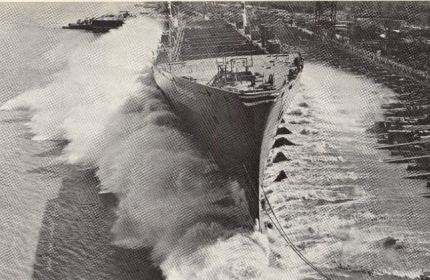FreightWaves Classics is sponsored by Old Dominion Freight Line — Helping the World Keep Promises. Learn more here.
FreightWaves explores the archives of American Shipper’s nearly 70-year-old collection of shipping and maritime publications to showcase interesting freight stories of long ago.
In this edition, from the November 1974 issue of American Shipper, FreightWaves shares an article about a record-breaking number of LASH (Lighter Aboard Ship) vessels built that year. While these ships aren’t in much use today since container ships became the common vessel, in 1974, they were the shiny new thing.
20th U.S.-flag LASH ship launched; Becomes 25th barge carrier in world
The 20th LASH cargo liner — a record setting number of standard-design cargo vessels built consecutively by any U.S. shipyard during peacetime — thundered down the launchways at Avondale Shipyards September 28.
The vessel was Central Gulf Line’s S/S Green Island, an 893-ft. long, 46,000-ton ship which concluded Central Gulf’s current expansion program for its U.S.-flag fleet.
Avondale built the world’s first LASH ship in 1969 when it delivered the S/S Acadia Forest to Central Gulf for operation under the Norwegian flag. The Acadia Forest loaded its first cargo at Panama City, Florida, that year.
Since that date, Avondale has fulfilled contracts for more than a half billion dollars of LASH ships.
In addition, two European yards built the LASH carriers S/S Bilderdyk and S/S Muenchen for Combi Line. Lykes Bros. Steamship Co. had three SEABEE class barge-carrying ships built at the General Dynamics yard in Quincy, Massachusetts.
Together, the two yards have delivered a total of 25 oceangoing barge carriers operating on a worldwide basis in the Atlantic, Pacific and Indian Oceans.
At launching ceremonies for the Green Island, Central Gulf President Erik F. Johnsen described completion of his company’s LASH program as a “creative and productive effort that inspires renewal of our faith in our competitive free enterprise system and the American genius for out-producing any nation in the world.”
Johnsen noted that the LASH ships were designed by New Orleans Naval Architect Jerome L. Goldman. He also noted participation by the United States Government and Central Gulf’s parent company, Trans Union Corporation. Louisiana Senator J. Bennett Johnston was a participant in the launching ceremony, describing the work as “an answer to those who would prophesy a gloomy economic picture for America.” He predicted that “foreign domination of the sea will surrender a major portion of the world trade market in the 1970’s to the United States.
“I foresee a day when America and Louisiana regain their rightful place in world shipping,” Johnston said. “It will be a day when we have a deepwater port for Louisiana, capable of handling the big new tankers. I foresee a day when the Red River is navigable all the way to Shreveport and beyond — a time when a north/south highway helps funnel even more business from the nation’s heartland to the nation’s second-busiest port.
“During World War II, the American shipbuilding industry proved itself capable of meeting the threat to American military domination when it worked the miracle of the Liberty ships, astounding the world with its productive capacity,” the senator said. “We are no less threatened today — albeit on the level of world economics — by foreign domination of the sea. So I say to you that it is my hope that the ‘Green Valley’ and her sister LASH ships are the vanguard of the renaissance in American shipbuilding innovation and success.”
The Green Island like its sisterships designed by Friede & Goldman, Inc. has overall length of 893 ft., beam of 100 ft., molded depth of 60 ft., service speed of 22 knots, and the capacity to carry 33,000 tons of cargo in 89 loaded barges plus additional vessel space for thousands of tons of cargo in deep tanks.
Three days after Central Gulf’s launching, Prudential Line took delivery at New Orleans of its fourth and fifth LASH ships, the LASH Atlantico and LASH Pacifico”at Avondale.
The Prudential LASH ships are 820 ft. long and were initially designed to transport 62 barges or lighters and 322 containers (20-ft. equivalent).
The two ships have joined the LASH Espana, LASH Italia and LASH Turkeye in trade from New York, Norfolk and Charleston to the Mediterranean with feeder services from Baltimore, Philadelphia and Savannah.
FreightWaves Classics articles look at various aspects of the transportation industry’s history. Click here to subscribe to our newsletter!
Have a topic you want me to cover? Email me at bjaekel@freightwaves.com or follow me on Twitter.
The post The barge carrier craze of the 1970s appeared first on FreightWaves.













